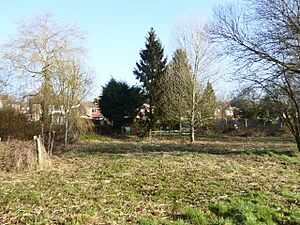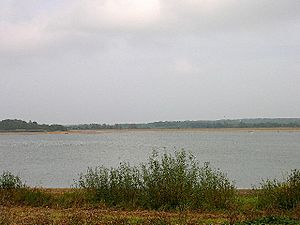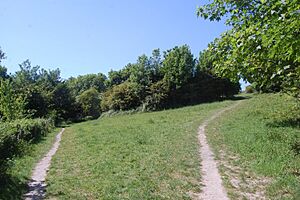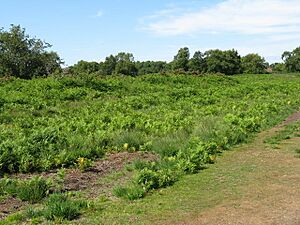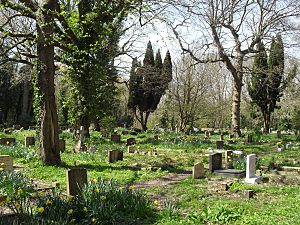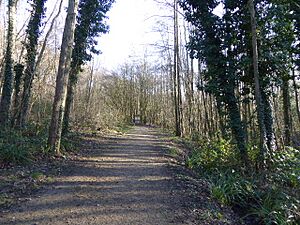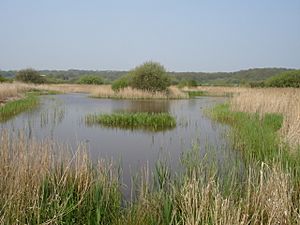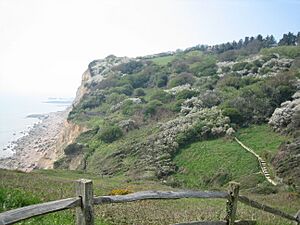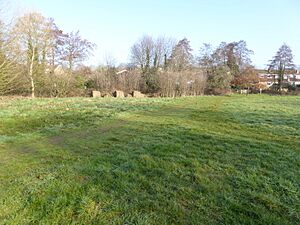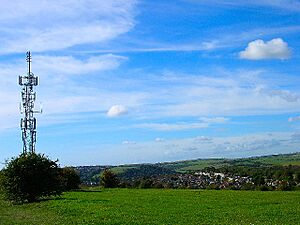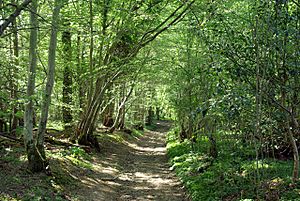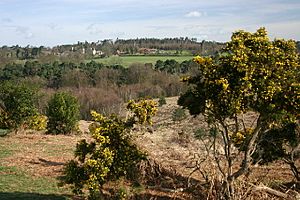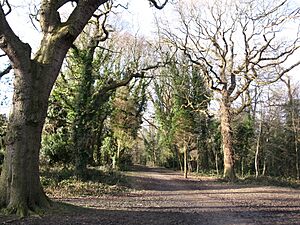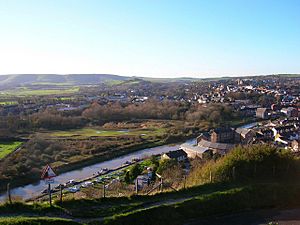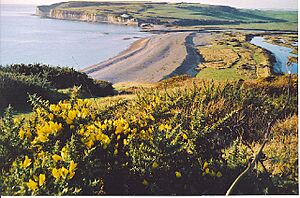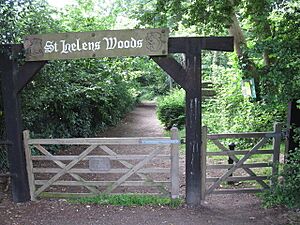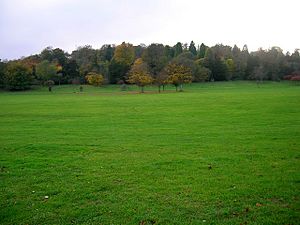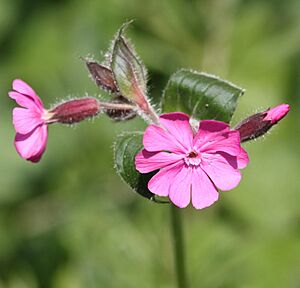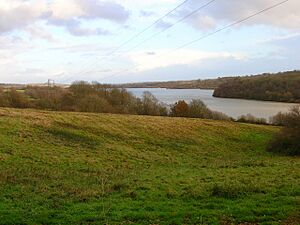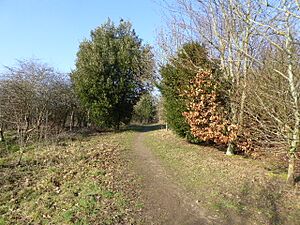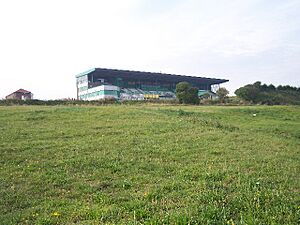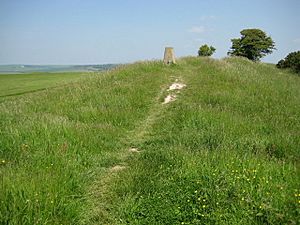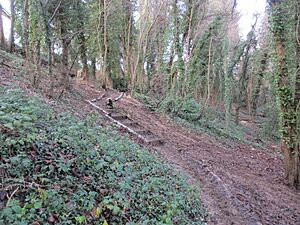List of local nature reserves in East Sussex facts for kids
Local Nature Reserves (LNRs) are special places in the United Kingdom that local councils protect. Think of them as nature's playgrounds and classrooms! To become an LNR, a place must be important for its plants, animals, or rocks. The local council needs to have control over the land, either by owning it or having an agreement with the owner. They make sure these areas are looked after and can even set special rules to keep them safe for nature.
East Sussex is a county in South East England. It's next to Kent on one side and West Sussex on the other, with Surrey to the north and the English Channel to the south. It's a pretty big area, about 1,725 square kilometers (666 square miles), and around 552,000 people lived there in 2018.
As of July 2019, East Sussex has 26 Local Nature Reserves. Many of these places have extra special protections too. For example, ten are Sites of Special Scientific Interest (SSSI), which means they are important for their wildlife or geology across the whole country. Some are also important for birds or specific habitats across Europe and even the world! Six of these reserves are managed by the Sussex Wildlife Trust, a charity that helps protect wildlife.
Contents
- Understanding the Special Names
- Amazing Nature Reserves in East Sussex
- Arlington Reservoir
- Beacon Hill
- Benfield Hill
- Bevendean Down
- Castle Hill, Newhaven
- Chailey Common
- Church Wood and Robsack Wood
- Crowborough Country Park
- Filsham Reed Beds
- Hastings Country Park and Fairlight Place Farm
- Hempstead Meadow
- Ladies Mile
- Marline Wood
- Old Lodge
- Old Roar Gill and Coronation Wood
- Railway Land, Lewes
- Rye Harbour
- Seaford Head
- St Helen's Wood
- Stanmer Park/Coldean
- Summerfields Wood
- Weir Wood Reservoir
- West Park, Uckfield
- Whitehawk Hill
- Wild Park/Hollingbury
- Withdean and Westdene Woods
Understanding the Special Names
When you see these special names for nature sites, they tell you why the place is important. Here's what some of them mean:
- GCR = A Geological Conservation Review site is a place important for its rocks and how the Earth was formed.
- NCR = A Nature Conservation Review site is a place that's really important for its wildlife and natural features.
- Ramsar = A Ramsar site is a wetland (like a marsh or a lake) that is important all over the world, especially for water birds.
- SAC = A Special Area of Conservation is a place protected for its rare or threatened habitats and species in Europe.
- SM = A Scheduled monument is an important historical site, like an old fort or burial ground.
- SPA = A Special Protection Area is a place protected for its rare or important birds in Europe.
- SSSI = A Site of Special Scientific Interest is a place that's very important for its wildlife, plants, or geology in the UK.
- SWT = The Sussex Wildlife Trust is a charity that helps protect wildlife and wild places.
Amazing Nature Reserves in East Sussex
Arlington Reservoir
This huge reservoir is a fantastic spot for birds, especially in winter. More than 10,000 birds come here, including lots of wigeon. Over 170 different types of birds have been seen passing through! The River Cuckmere flows through the reservoir, and you can find areas with tall fen plants and exposed shingle.
Beacon Hill
Beacon Hill is a beautiful chalk grassland with amazing views of the sea and the land around it. You might spot pretty flowers like round-headed rampion and different kinds of orchids. Birds like skylarks also live here. There's even an old windmill, Rottingdean Windmill, which is a protected historical building.
Benfield Hill
Benfield Hill is an area of grassland and scrub on sunny slopes. It's famous for having many glow-worms, which are beetles that glow in the dark!
Bevendean Down
Bevendean Down is made up of five different parts, mostly chalk grassland. It also has woodlands and scrub. You can find a special dew pond here, along with various orchids and cool insects like the Adonis blue butterfly and the hornet robberfly.
Castle Hill, Newhaven
From Castle Hill, Newhaven, you get great views of the sea, the Downs, and Newhaven. This site has important cliffs, scrub, and grassy areas. It's home to several badger setts, sea birds, slow worms, and common lizards.
Chailey Common
Chailey Common is a large common with many different habitats like grasslands, marshes, and heathland. It even has a stream and ponds. It's a butterfly paradise, with species like the silver-studded blue, grayling, pearl-bordered fritillary, and green hairstreak.
Church Wood and Robsack Wood
This site, Church Wood and Robsack Wood, is split into four areas. It has natural woodlands, grasslands, and streams. In the woodland, you can find interesting plants like toothwort, goldilocks buttercup, and early purple orchid.
Crowborough Country Park
Crowborough Country Park has lots of different habitats, including wet and dry woodlands, grassy areas, marshes, streams, and ponds. A main stream flows through a steep, rocky gorge. Look out for the rare moss called Discelium nudum here.
Filsham Reed Beds
Filsham Reed Beds is one of the biggest reedbeds in East Sussex. It also has marshland, swamps, and old woodlands. Over 1,000 different types of tiny creatures (invertebrates) have been found here! It's a very important place for birds like Cetti's warbler, reed bunting, and water rail.
Hastings Country Park and Fairlight Place Farm
Hastings Country Park and Fairlight Place Farm offers amazing views of Hastings and the cliffs. You can even see dinosaur footprints in the rocks by the sea, and many fossils! The park has cliff-top grasslands, heathland, and woodlands, where you might find rare liverworts and mosses.
Hempstead Meadow
Hempstead Meadow is mostly wet grassland with some trees and bushes. You can find primroses, tussock sedge, and different ferns here. Bats love to visit this meadow to find food.
Ladies Mile
Ladies Mile is a grassland area with lots of horseshoe vetch and kidney vetch flowers. There are also some bushes and a small wood at one end.
Marline Wood
Marline Wood has very old woodland and rich grasslands. The wood has tall pedunculate oak trees and younger trees like hornbeam and hazel. A stream runs through a steep valley, where you can find 61 types of mosses and liverworts, including some rare ones.
Old Lodge
Old Lodge is a highland area mostly covered in grassland and heather, with some gorse bushes and scattered birch and oak trees. There are also small Scots pine forests. Birds like common redstart and common crossbills live here, and you can see large nests made by red wood ants.
Old Roar Gill and Coronation Wood
Old Roar Gill and Coronation Wood has open water, broadleaved woodland, ferns, and tall plants. Old Roar Gill is a narrow, steep valley. It's home to uncommon liverworts, mosses, and lichens, as well as rare insects like Rolph's door snail.
Railway Land, Lewes
Railway Land, Lewes used to be a railway yard but now it's a nature haven! It has grasslands, wet willow woodlands, meadows, reedbeds, and a network of ditches. A stream that flows with the tides is also here. Birds like woodpeckers, kestrels, and kingfishers can be seen.
Rye Harbour
Rye Harbour is a huge nature reserve with many different coastal habitats, such as saltmarsh, shingle beaches, reedbeds, and lagoons. Over 280 types of birds have been seen here, and 90 of them breed on the site! There are also more than 450 kinds of flowering plants, including some very rare ones.
Seaford Head
Seaford Head has many different habitats, including chalk grassland, chalk cliffs, and shingle beaches. The grassland has beautiful flowers like kidney vetch and clustered bellflower. You can also spot butterflies like the silver-spotted skipper and chalkhill blue.
St Helen's Wood
St Helen's Wood is known for its many broad-leaved helleborine plants. It also has grassland areas where horses graze to help manage the plants. You might see meadow flowers like red bartsia and green-winged orchids here.
Stanmer Park/Coldean
Stanmer Park/Coldean is an old park from the 1700s. It has mature woodlands with ancient beech trees and bluebells, as well as chalk grassland and a tree collection (arboretum).
Summerfields Wood
Summerfields Wood is a natural woodland with many paths and ponds. It's a great place for birdwatching, with species like firecrest, whinchat, and wood warbler.
Weir Wood Reservoir
Weir Wood Reservoir is one of the largest open water areas in East Sussex. It's a very important place for birds that breed, spend the winter, or just pass through. You can see birds like great crested grebe, teal, and mute swan here.
West Park, Uckfield
West Park, Uckfield has grasslands, woodlands, and a marshy area. This marshy part is special because it's home to several types of orchids, including the southern marsh orchid. There's also a group of dormice living here.
Whitehawk Hill
Whitehawk Hill has beautiful chalk grassland with many different plant species. From here, you can see great views over Brighton and the sea, and even the Isle of Wight on clear days. It's also home to colonies of chalkhill blue butterflies.
Wild Park/Hollingbury
Wild Park/Hollingbury offers views over Brighton. Its rich chalk grassland is kept healthy by sheep grazing. There's also a large woodland with paths, an Iron Age hillfort (an ancient fort), a golf course, and a dew pond.
Withdean and Westdene Woods
Many of the old trees in Withdean and Westdene Woods were lost in a big storm in 1987. However, it's still home to many mammals like foxes, badgers, and common pipistrelle bats. You can also spot birds like great spotted woodpecker and firecrests.


